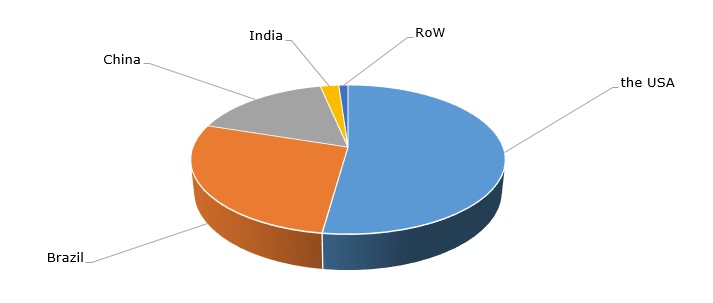The production of transport fuel has long been the major outlet for ethanol. This fuel is derived from various cellulosic biomass feedstocks via the method of the fermentation of available carbohydrates, like simple sugars, or via second-generation ethanol technology. The end product, i.e. bioethanol, can be used in different gasoline blends. Such blends can contain a wide range of ethanol – from 5-15% (e.g., E10 used in unmodified vehicles) to almost 100% (e.g. E85 or E95 suitable for so-called flexible fuel vehicles or FFVs).
In an effort to cut carbon emissions, many governments attempt to reduce the consumption of fossil fuels, improve the fuel efficiency of vehicles and stimulate the production of higher biofuel blends. In the USA, biodiesel, when compared to petroleum diesel fuel, has a capacity to reduce GHG emissions by 50-85 percent, which is a significant value. The policy to promote biofuels, including bioethanol and biomass-based diesel, finds manifestation in numerous laws, directives, standards, taxation initiatives, subsidies, etc. A newly established Biofuture Platform is a vivid manifestation of collaborative endeavors to promote biofuels when different countries join their resources and expertise for this purpose. Brazil, being the world’s largest producer of sugar and second largest producer of both ethanol and biodiesel, is the main motor behind this platform. The Brazilian government encourages fuel programs to use high percentages of ethanol in gasoline. The country’s ethanol production capacity exceeds 30 mln tonnes. The leader in Brazilian ethanol business is sugar and ethanol giant Biosev S.A., which has almost 2 mln tonnes in ethanol capacity alone.
Ethanol: structure of global production by country

However, the spread of biofuels does not progress without a competition. The proliferation of electric vehicles, no matter how slow this process is, makes the bioethanol ‘party’ apprehensive of its future. Bioethanol mpromotersers and promotors, therefore, speak about their products as an immediate solution or a solution that might be more prominent in such areas as aviation, where the role of electric propulsion may be subdued.
Such allegations of bioethanol supporters may look highly problematic in light of the current plans, for instance, by Spain to ban new cars with petrol or diesel engines until 2040. In November 2018, this country unveiled an ambitious plan to switch its electricity system entirely to renewable sources and decarbonize its economy closer to 2050. Of course, policy-making initiatives of the current Spanish government may be revised by succeeding, less environmentally concerned, politicians.
This confirms the fact the bioethanol, ethanol and other industries, in general, are highly susceptible to the influence of various factors, including market regulation, policy making, macroeconomic situation or environmental protection trends.
Another serious objection to the bioethanol industry development comes from the fact that the conversion of land to supply bioethanol may lead to significant destruction of forests and wetlands, thus causing a release of the large quantities of carbon emissions. This objection is also supported by key environmental groups, such as Greenpeace and the Nature and Biodiversity Conservation Union (NABU). New technologies of bioethanol production may cope with this issue.
There are also technical issues related to the use of bioethanol in cars. For instance, the recent announcement by the British Department for Transport to encourage the introduction of E10 fuel, which uses 10 percent of bioethanol, in the UK may be confronted by the fact that many local cars are not compatible with this type of petrol. However, such discrepancies characterize nearly every technological ‘solution’ to the current environmental crisis, which also means that any technology alone is unable to address this crisis and holistic approach is needed for that.
A comprehensive analysis of the ethanol market can be found in the in-demand research study “Ethanol (EtOH): 2018 World Market Outlook and Forecast up to 2027”.
